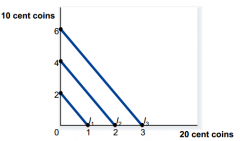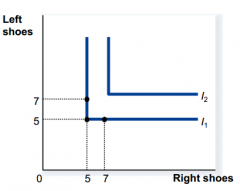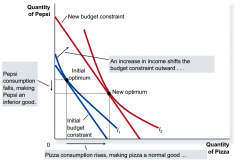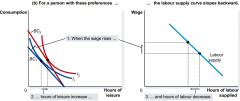![]()
![]()
![]()
Use LEFT and RIGHT arrow keys to navigate between flashcards;
Use UP and DOWN arrow keys to flip the card;
H to show hint;
A reads text to speech;
16 Cards in this Set
- Front
- Back
|
Indifference curve
|
shows consumption bundles that give the
consumer the same level of satisfaction/ utility. |
|
|
Marginal rate of substitution
|
• It is the rate at which a consumer is willing to
trade one good for another. => The slope at any point on an indifference curve. |
|
|
Four properties of Indifference Curves
|
1. Higher indifference curves are preferred
to lower ones. 2. Indifference curves are downward-sloping. 3. Indifference curves do not cross. 4. Indifference curves are bowed inwards. |
|
|
Why is an indifference curve downward-sloping?
|
A consumer is willing to give up one good only if
he or she gets more of the other good in order to remain equally happy. – If the quantity of one good is reduced, the quantity of the other good must increase. |
|
|
Why is an indifference curve bowed inwards?
|
– Consumers more willing to trade away goods they
have in abundance, – Differences in a consumer’s marginal substitution rates cause indifference curves to bow inward. |
|
|
Perfect substitutes
|

– The marginal rate of substitution is a fixed
number. |
|
|
Perfect complements
|

- Two goods with right-angle indifference
curves are perfect complements. |
|
|
The Consumer’s Optimum
|

At the consumer’s optimum, the consumer’s
valuation of the two goods equals the market’s valuation. |
|
|
Inferior Good as Income Rises
|

|
|
|
A fall in the price of one good
|

A fall in the price of any good rotates the budget
constraint outward and changes the slope of the budget constraint. |
|
|
Income effect
|
The change in consumption that results when a price change moves the consumer to a higher or lower
indifference curve. |
|
|
Substitution effect
|
The change in consumption that results when a price change moves the consumer along an indifference
curve to a point with a new marginal rate of substitution. |
|
|
Deriving the Demand Curve
|

Demand curve can be viewed as a summary of
the optimal decisions that arise from his or her budget constraint and indifference curves. |
|
|
Giffen goods
|
• Giffen goods are inferior goods for which an
increase in the price raises the quantity demanded. |
|
|
How do wages affect labour supply?
|
– If the substitution effect is greater than the
income effect for the worker, he or she works more. – If income effect is greater than the substitution effect, he or she works less. |
|
|
Hours of Work/ Consumption vs Hours of Leisure
An increase in the wage: |

|

